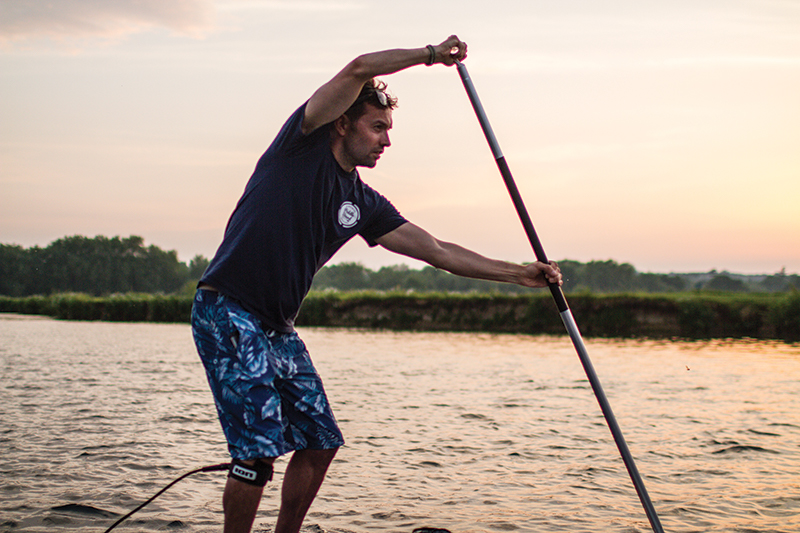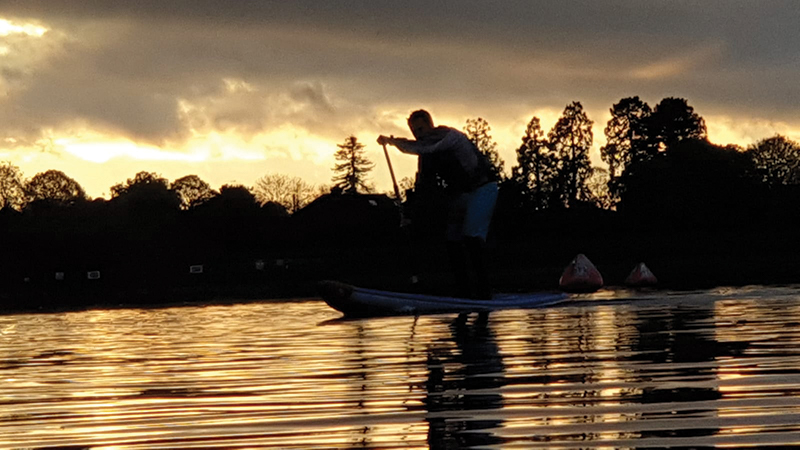BESTFIT Tries Paddleboarding
BESTFIT Tries Paddleboarding
Share
It might be cold right now but spring is just around the corner, which means now is the perfect time to perfect your paddleboarding tekkers for the summer ahead. BESTFIT tackled the winter waters to see what the UK’s fastest-growing water sport is all about…

Water sports in the UK are big business and at the forefront of this growing trend is paddleboarding. Originating in Hawaii in the 1930s thanks to a pioneering chap called Thomas Edward Blake, the sport of paddleboarding has taken some time to grow in popularity on these shores. If you haven’t seen someone doing it, which is increasingly unlikely, it basically involves riding a board and using a paddle to propel yourself forward, much like a kayaker does while prone. Rather than just surf waves, paddleboarding enables you to cruise any stretch of water, which means anyone can give it a go anywhere and at a pace that suits them. And while surfers rely on nature for waves, and now inland wave machines, not to mention a considerable amount of expertise to conquer whatever nature throws at them, paddleboarders can use lakes, rivers or canals, as well as the sea, which makes it more inclusive for all ages and abilities. Moreover, and here’s the real kicker for its exponential growth, is that as well as hard boards, there are inflatable boards called isups. These can be folded and easily transported in a big rucksack, rather than having to rely on garage space for storage and roof racks/trailers for transportation. Game changer.
WORK YOUR BODY
Oh, and it’s really good for you, which is why we’re doing it, obviously. Even a leisurely SUP – that’s a paddle session to you and I – down a river or on a lake admiring the scenery will involve every muscle in your body. You will use your legs, back, core and abdominal muscles to achieve balance, and your arms, back and shoulders to propel yourself forwards. If you move onto a livelier river or into the sea you’ll face waves and currents, which means your workout will intensify. Start introducing speed or distance and you’ll soon become a lean machine.
And while there are more and more places offering paddleboard hire and lessons around the country, from canals to coastline, rivers to lakes, the number of paddleboard events are also growing in number. There’s a race scene for those who want to test their speed, with events catering for those with inflatable boards – including a category that tests people on exactly the same board for fairness – and those who mean business and who have carbon boards. Beyond that, there are distance events such as the Head of the Dart, a 10-mile race from Dartmouth to Totnes, or the Trent 100, a team event that involves as entering as a team and completing 100km over two days. There are obstacle course events, SUPathlons… SUP events with runs and bike events attached. Something for everyone and all abilities.
Of course, key to being able to paddleboard is balance. If you’ve ever tried surfing, you’ll know standing on a board on a wave is a difficult skill to master. Paddleboarding requires you to stand upright for longer periods but, if you’re not on the sea, you have the benefit of not having to contend with the waves. Still, standing on any stretch of water requires a certain level of core stability and strength. Your first attempt will inevitably involve some shaking at the ankles, knees or both. This will relent as your body adapts and you hone your position and technique, which can then help you paddle longer distances, go quicker and with greater efficiency, or to surf waves. You’ll soon notice how your day-to-day balance – and core strength – improves.
If you’ve ever trained for a running event you’ll know how the repetitive movement of running can damage your joints, ligaments and tendons. Similarly, lifting weights comes with risk. SUPping enables you to burn calories without damaging your joints. A leisurely SUP can still burn up to 400 calories in an hour. Introduce some surfing and that will rise to up to 750. Perfect the technique of your stroke and each one will be the equivalent of doing an abdominal crunch.
It’s great for the guns, too. Even an hour on a paddleboard in calm water is enough for you to notice soreness in your arms, feet and/or legs. A sedate session will improve your overall body strength, so imagine the benefits of a strenuous session. Your arms are the supporting cast to your core. Even carrying your board to your launching point will boost your biceps.

OVER LAND AND SEA
We started on the river and, after an initial element of shakiness, comfortably handled a 90-minute session. We then attended a specialised race training session with world no.2 April Zilg in the sea. This brings a number of external factors into play, namely swell, wave height and frequency, plus the aim was to go as quick as possible rather than amble down the river. The difference was intense. With legs locked and loaded, we were constantly having to adjust our balance to stay upright to combat the waves and in doing so, we worked our core, glutes and hamstrings. Then, to build the speed, we’re went from the upright position that proved sufficient for the river, to leaning as far forward as our balance would let us to ‘catch’ us much water as possible and pull ourselves forward with a hefty pulling motion in one efficient stroke. At the same time, we were told to thrust our pelvis forward in an effort to maximise our forward momentum. If you use a ski erg, imagine doing that on a bosu ball… and with someone rocking it, and you get the idea! It’s an incredible all-over body workout that intensifies with speed, motion and distance… and waves. And the more you perfect the technique, the better the overall workout.
Not surprisingly, it’s a big win when it comes to cardio, too. Whatever level you’re at, from light sessions on calm water to vigorous SUPs in the sea, your body’s endurance levels will rocket. You can lose weight and reduce the chances of diabetes, heart attack, stroke and more.
HEAD STRONG
And then there are the mental benefits. Exercising outside is a massive and yet simple victory for your wellbeing. Add to this the relevant calm of being on water, and the soothing sounds will evaporate any stress you’re experiencing. When we paddled on the river we were surrounded by stunning countryside and wildlife. When we transitioned into the sea, the backdrop transformed with England’s incredible coastline. All of these things are excellent for your mental health and enable you to be at one with your surroundings. And with an injection of vitamin D to help you fend off fatigue, depression, bone weakness, chronic pain and more, it’s a no brainer. Moreover, paddle boarding can take you to places inaccessible by feet or car, and you’ll likely leave your phone on dry land. Enjoy some time with your mind and without distraction. You won’t regret it.

GIVE IT A GO
If this sounds like something you might consider, then there’s bound to be a club or instructor near you. There are hundreds of clubs and groups now springing up around the country. Hook up, join in and socialise. And even if you conquer it straight away, there are numerous ways to adapt and evolve your involvement in the sport, and the equipment you use.
To find out more visit www.busap.org.uk













FOLLOW BESTFIT